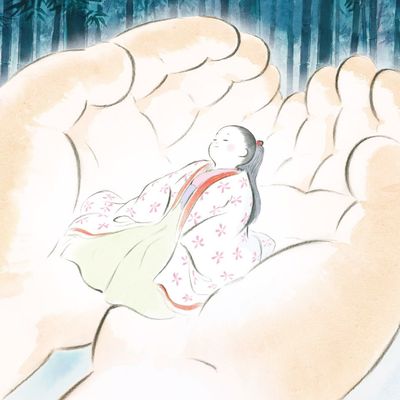
Magical and melancholy, The Tale of the Princess Kaguya comes from the other mad genius of Studio Ghibli, Isao Takahata, who co-founded the beloved Japanese animation company alongside the great Hayao Miyazaki back in 1985. Somewhat more idiosyncratic than Miyazaki — and with a darker streak — Takahata was responsible for 1988’s war drama Grave of the Fireflies, still probably the most scarring animated film I’ve ever seen, but also possibly the most beautiful. The Tale of the Princess Kaguya is a gentler work, and at first, it feels slighter, too. Based on an old, popular Japanese legend, it starts off like an odd little fable, but then its expansive sadness sneaks up on you.
Hand-drawn, in a style that looks to my untrained eye at times like lightly colored charcoal sketches, Kaguya begins with a bamboo cutter discovering a mysterious, teeny-tiny, elegantly dressed girl inside a glowing bamboo stalk. He takes her as a blessing and brings her home to his wife, whereupon the miniature girl turns into an actual human baby. The childless couple decides to raise her — and the wife immediately begins to lactate. The bamboo cutter is convinced that the girl’s earlier appearance was Heaven telling them who she will become later in life. At any rate, it’s clear this is no ordinary child: Within minutes, she’s already started to grow. Within days, she’s walking and talking and even singing. (Her voice has been dubbed in the film’s U.S. version by Chloë Grace Moretz.)
The village kids call her “Li’l Bamboo”; her parents call her “Princess.” It speaks to a deeper divide: She enjoys the immediacy and vibrancy of life in the country and near nature (she did, after all, emerge from a magic bamboo stalk), but her parents’ belief in her noble destiny pushes all that away. When the same bamboo stalk that brought her also yields a small fortune in gold and rich fabrics, the parents decide to move Kaguya to a palatial estate closer to the city. To them, she becomes a manifestation of their dreams. But to the film’s credit, it never loses sight of the parents’ goodness, either — they are vulnerable, caring, and misguided. This is a Ghibli movie, after all: Amid the mad swirl of even their most far-fetched films, their characters remain messy, human, and recognizable.
Once Princess Kaguya is introduced to high society, she is coveted by five men of noble breeding. She sets impossible tasks for them, not because she wants them to prove their worthiness, but because she wants them out of her life. She doesn’t want to belong to anybody. Not even, really, to her close childhood friend Sutemaru, who also pines for her. This isn’t just a simple tale of independence, however (though it is partly that, too). There’s something else going on here — a curious, gathering sadness to Kaguya that eventually sends the story in a wonderfully surreal and even more symbolic direction. Like most good stories about providence, Princess Kaguya really turns out to be a story about loss. And like most good stories about loss, it’s a lament for, and a celebration of, our own humanity.
The actual animation in Princess Kaguya is austere and simple: Often, only the main focus of a given frame — a character, an object — is in motion, with everything else unnaturally frozen. Sometimes, the entire frame goes completely still. You would think that such stillness would give this world added solidity. But coupled with the animation’s light strokes and muted colors, the image feels more fragile, impermanent, as if the smallest brush could easily wipe it all off the screen. The possibility of loss has become part of the film’s very texture.
The Tale of the Princess Kaguya has a quiet way about it, but its sense of metaphor is deep and refined. At one point, Kaguya plants a small garden in her elegant home, then puts her head down to the ground to look at it up close. “It looks different from here,” she says, and we watch through her eyes: The garden has become a teeming forest, an echo of her sweet, innocent days back amid the reeds, fields, and bamboo stalks. It’s a simple little scene, but the yearning in it — and all that it speaks to — takes your breath away. It is said that, not unlike Miyazaki and last year’s wonderful The Wind Rises, this might be Takahata’s last film. It’s a good one for a legend to go out on.


